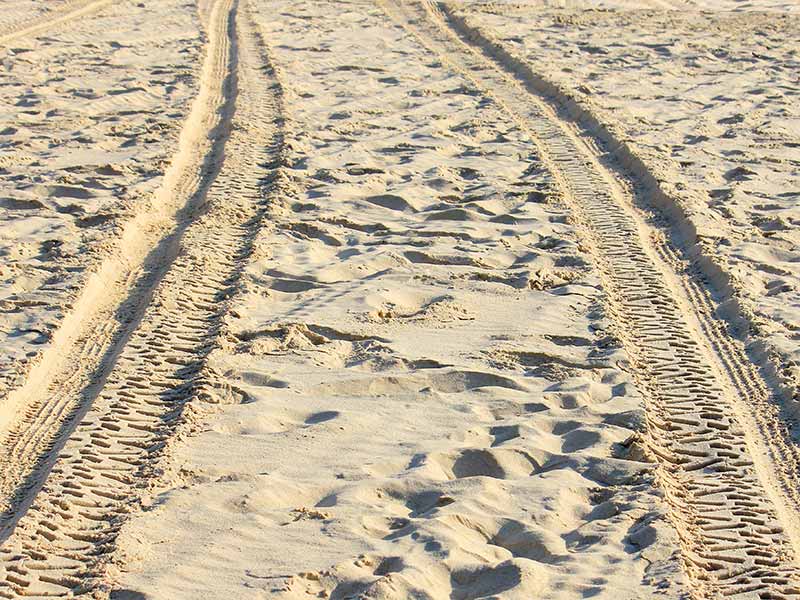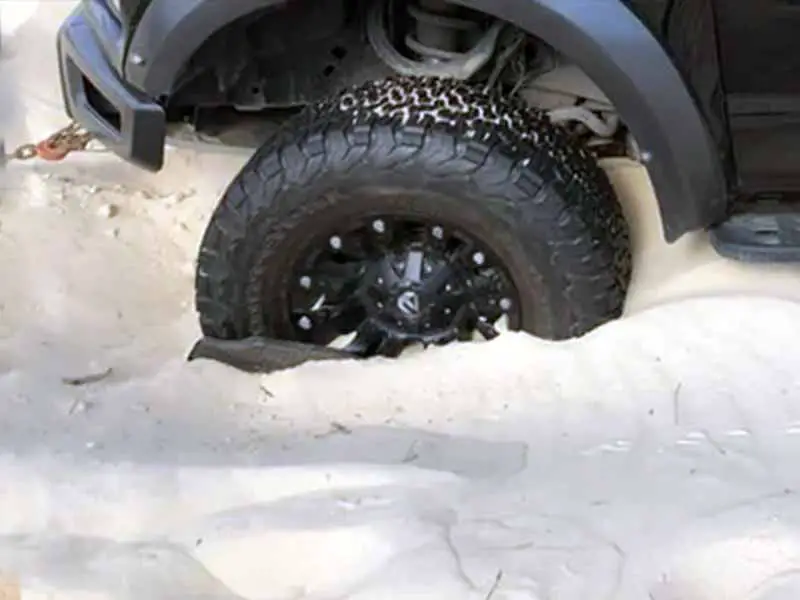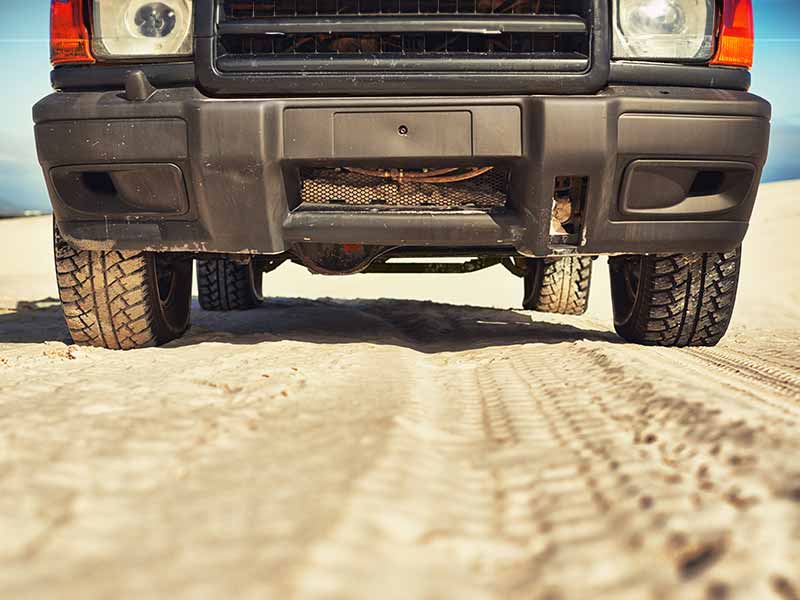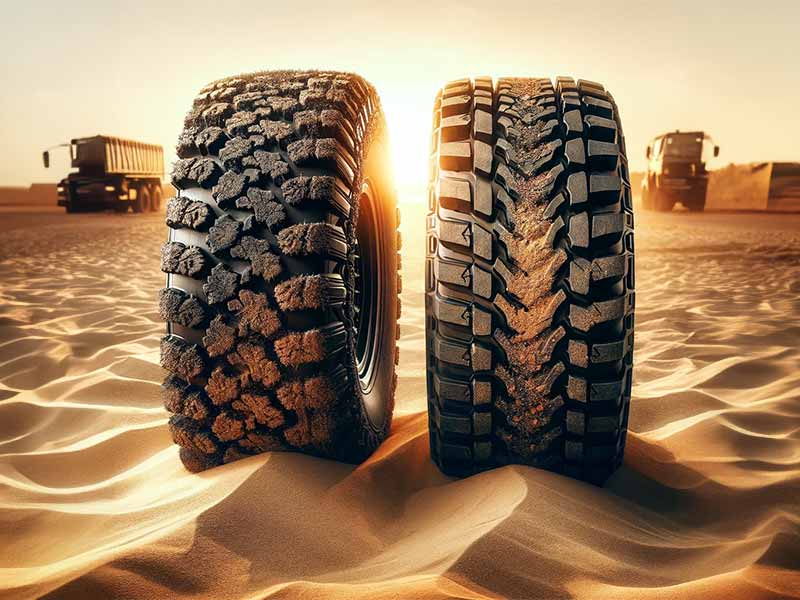Have you ever wondered if mud-terrain tires are the right choice for driving in sand, or if all-terrain tires might offer a better experience? This question is especially pertinent for adventurers looking to navigate sandy terrains effectively.
Mud-terrain tires are designed primarily for off-road conditions like mud and loose gravel and might not be the best option for soft, deep sand due to their aggressive tread patterns.
All-terrain tires, offering a more balanced performance across various conditions, including sand, might be the more versatile choice for diverse driving environments.
In this article, we’ll explore the key differences between mud-terrain and all-terrain tires, focusing on their design, performance in sand, and the pros and cons of each type. We aim to provide a clear understanding of which tire might be best suited for your specific sand-driving needs.

Understanding Tire Types
Choosing the right tire for your vehicle is crucial, not just for safety but also for optimizing performance, especially when tackling different terrains. Today, we’re diving deep into the world of mud-terrain and all-terrain tires, exploring their design, uses, and how they fare in sandy conditions. Let’s get rolling!
Mud-Terrain Tires
Mud-terrain tires are the rough-and-tumble members of the tire family, built to handle the messiest of conditions. Here’s what sets them apart:
- Deep Tread Patterns: These tires feature aggressive tread designs with deep grooves and large voids between tread blocks, designed to bite into soft ground and eject mud as they spin.
- Reinforced Sidewalls: To battle against sharp rocks and other off-road hazards, mud-terrain tires come with extra-thick sidewalls.
- Primary Use: They shine in off-road conditions like mud, rocky terrain, and loose surfaces, where their aggressive tread pattern can dig in and find traction.
Mud-terrain tires are the go-to choice for off-road enthusiasts who demand maximum performance in the roughest terrains. However, their aggressive design means they can be overkill for more tame conditions, and they might not provide the most comfortable or efficient ride on pavement.
All-Terrain Tires
All-terrain tires are the Swiss Army knives of the tire world, offering a balance between off-road capability and on-road manners. Here’s why they’re so versatile:
- Intermediate Tread Depth: Their tread patterns are designed to handle a variety of surfaces, with wider grooves than street tires but closer spaced than mud-terrain tires.
- Versatility: These tires can manage light mud, gravel, grass, and even snowy conditions without sacrificing too much comfort on the road.
- Primary Use: All-terrain tires are best suited for drivers who split their time between off-road trails and paved roads, providing a comfortable ride in both scenarios.
The allure of all-terrain tires lies in their ability to offer reliable performance across a broad range of conditions. They might not match the off-road prowess of mud-terrain tires in extreme conditions, but for many drivers, they strike the perfect balance between off-road adventure and everyday drivability.
Key Takeaways
- Mud-Terrain Tires: Best for drivers who frequently tackle severe off-road conditions and are willing to trade off some road comfort for superior off-road traction.
- All-Terrain Tires: Ideal for those who need a tire that can do it all, offering a good mix of off-road capability and on-road performance.

Performance in Sand
Navigating through sand requires tires that can provide both traction and flotation to avoid getting bogged down. Let’s explore how mud-terrain and all-terrain tires stack up when it comes to sandy terrains.
Mud-Terrain Tires in Sand
Mud-terrain tires, with their aggressive tread patterns and large voids, have unique characteristics affecting their performance in sand:
- Traction vs. Flotation: The deep treads can offer excellent traction by digging into the surface. However, in very soft, deep sand, there’s a risk they might dig in too much, leading to potential issues with getting stuck.
- Best Conditions: They tend to perform better in conditions where the sand is more compact or slightly wet, as the tires can grip without digging in excessively.
While mud-terrain tires can be a solid choice for driving on certain sandy terrains, their aggressive design might not always be the best for soft, loose sand where flotation is more critical than traction.
All-Terrain Tires in Sand
All-terrain tires, with their more balanced tread design, offer a different set of advantages in sandy conditions:
- Balanced Performance: The intermediate tread depth helps prevent the tires from digging too deeply into the sand, which can be beneficial for maintaining momentum and avoiding getting stuck.
- Versatility in Sand: They’re generally more versatile across different types of sand, from hard-packed to loose grains, providing a good balance of grip and flotation.
For drivers encountering a mix of sand conditions or looking for a tire that can handle sand without sacrificing performance on other surfaces, all-terrain tires might be the more practical choice.

Pros and Cons
When choosing between mud-terrain and all-terrain tires, especially for sand driving, it’s essential to weigh their advantages and disadvantages. This comparison will help you align your tire choice with your driving preferences and the conditions you’re most likely to encounter.
Mud-Terrain Tires
Mud-terrain tires are designed for the off-road enthusiast who demands the utmost in traction and durability in rough terrain. However, their specific attributes come with trade-offs.
- Pros:
- Superior Off-Road Traction: Exceptional grip in mud, on rocks, and in other challenging off-road conditions.
- Durable Design: Built to withstand punctures and abrasions, thanks to reinforced sidewalls and tough tread compounds.
- Cons:
- Limited Sand Performance: In soft, deep sand, the aggressive tread can dig in rather than float, potentially leading to getting stuck.
- On-Road Discomfort: Louder road noise and a rougher ride on pavement due to the aggressive tread pattern.
- Reduced Fuel Efficiency: The heavy-duty construction and tread design can lead to increased rolling resistance, reducing fuel economy.
All-Terrain Tires
All-terrain tires are the jack-of-all-trades, designed to offer a balanced performance both on and off the road, including in sandy conditions.
- Pros:
- Versatile Performance: Good traction on a variety of surfaces, including light mud, gravel, and sand, without sacrificing too much on-road comfort.
- Quieter Ride: Less noise on paved roads compared to mud-terrain tires, making them suitable for daily use.
- Better Fuel Efficiency: Typically, they offer better fuel economy than mud-terrain tires due to less aggressive tread patterns.
- Cons:
- Moderate Off-Road Capability: While versatile, they may not perform as well in extreme off-road conditions compared to mud-terrain tires.
- Wear Considerations: Depending on the brand and model, some all-terrain tires may wear faster on-road than tires specifically designed for highway use.

Choosing the Right Tire for Your Needs
Selecting the perfect tire requires a balance of factors, including your typical driving conditions, vehicle type, and personal preferences. Here’s how to navigate the decision-making process to ensure you equip your vehicle with the best possible tires for your adventures in sand and beyond.
Factors to Consider
When it comes to picking the right tire, here are some critical considerations to guide your choice:
- Driving Conditions: Assess the most common terrains you’ll encounter. If you frequently drive on sandy trails or dunes, focus on tires that offer the best performance in those conditions.
- On-Road vs. Off-Road Use: Determine the ratio of your on-road to off-road driving. If you spend most of your time on paved roads with occasional off-road excursions, all-terrain tires might be your best bet.
- Vehicle Type and Weight: Different vehicles respond differently to tire types. Heavy-duty trucks might benefit more from the durability of mud-terrain tires, while lighter SUVs and trucks might perform better with all-terrain tires.
- Personal Preferences: Consider your tolerance for road noise, ride comfort, and fuel efficiency. Mud-terrain tires might offer unparalleled off-road performance but can be louder and less comfortable on highways.
Recommendations for Different Scenarios
- Daily Driving with Occasional Off-Road Use: If your daily commute is on paved roads but you enjoy weekend off-road trips, all-terrain tires are likely the best choice. They provide a comfortable ride on the road while still being capable enough for most off-road conditions, including sand.
- Heavy Off-Road Use with Occasional Sand Driving: For those who tackle challenging off-road conditions regularly and only occasionally drive on sand, mud-terrain tires might be more appropriate. They offer the ruggedness required for severe off-roading, though they may require more caution in soft sand.
- Specific Sand Driving Needs: If sand driving is a significant part of your off-road adventures, consider specialized sand tires if applicable, or opt for all-terrain tires that are known to perform well in both loose and compacted sand conditions.
Resources
Below are some links you may find helpful when learning about tires
- Best tires for driving in sand – Motor Trend
- Tire tech: All-terrain vs mud-terrain tires – Driving Line
Final Thoughts
Choosing between mud-terrain and all-terrain tires for sand driving comes down to understanding the specific conditions you’ll encounter and balancing those against your overall driving needs.
Mud-terrain tires offer unparalleled performance in off-road conditions but may fall short in soft, deep sand. In contrast, all-terrain tires provide a versatile option that balances off-road capability with better performance on sand and paved roads.
Good luck and happy motoring.





